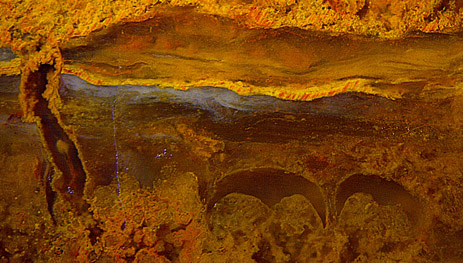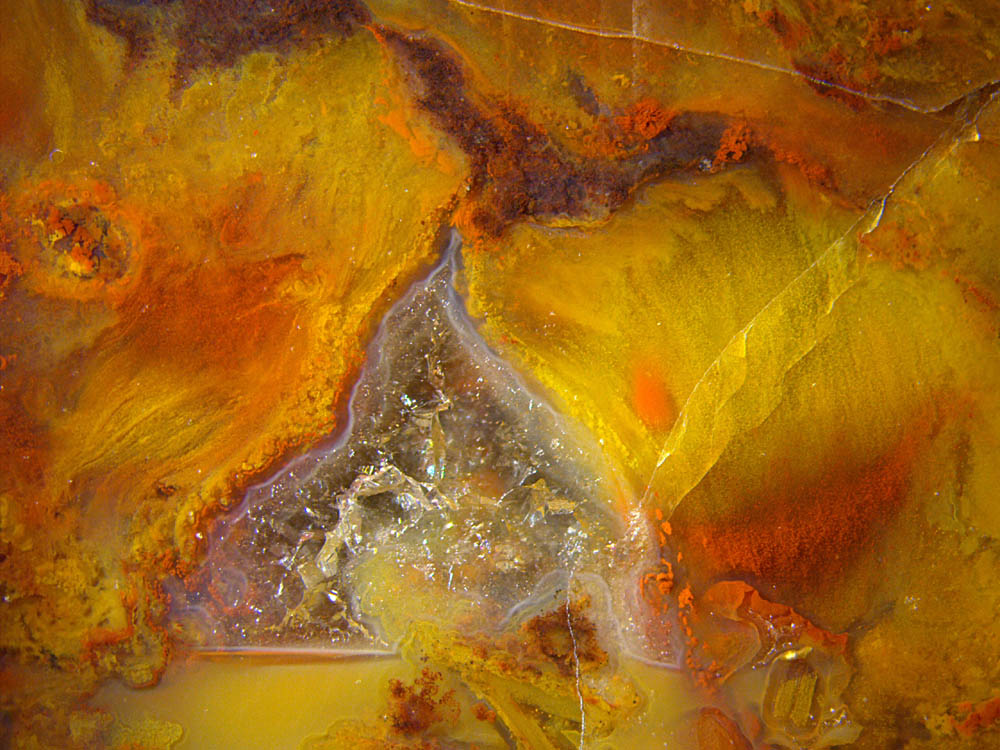What one piece of red chert can reveal
Red cherts found at a few small areas
in the Doehlen Basin near Dresden, Saxony, had formed by silicification
of silica-rich water and swamp matter, including plant fragments.
(Hence the statemet in [1] that cherts had formed only after deposition
of the surrounding rocks is false.)

Fig.1: Tree fern pinnule
cross-sections in stained chert. Image width 5mm.
Fig.2: Various mineralogical and biological phenomena
preserved
in an old fragment of a red chert layer thicker than 23cm,
with
microbial formations stained yellow and red.
Same
sample, same scale as Fig.1. Image width 11mm.
The pinnule cross-sections of the tree fern Scolecopteris in
Fig.1 imply that the chert had formed in a Permian swamp with tree
ferns fallen in.
 When
some of the Permian strata were eroded by the advancing Cretaceous sea,
the hard chert layers broke into boulders and pebbles rolling about on
the beach and getting buried in the sand which turned into Cretaceous
sandstone. When the
sandstone eroded in the
Tertiary the chert came out again. Judging
from loose samples, the thickness of the chert layers was up to about
30cm.
When
some of the Permian strata were eroded by the advancing Cretaceous sea,
the hard chert layers broke into boulders and pebbles rolling about on
the beach and getting buried in the sand which turned into Cretaceous
sandstone. When the
sandstone eroded in the
Tertiary the chert came out again. Judging
from loose samples, the thickness of the chert layers was up to about
30cm.
Since there were no deep valleys in the Doehlen
Basin at that time, the chert pieces were scattered over the area. Most
of them were washed to the sea when the valleys formed in the
Quaternary. A few can still be found in the remaining gravel deposits
of Tertiary or Quaternary streams. Their changeful history through the
ages is proven by small remains of sandstone adhering to them even now.
Still more interesting are the processes which
created colourful aspects as seen in Fig.2. The large yellow and red
parts on either side of the former water-filled cavity in the middle
seem to be freshwater stromatolites, layered deposits of
silica gel with cyanobacteria (?) on every layer, whose oxygen
production led to the deposition of yellow and red iron oxides so that
the thin layers became stained, less distinctly here than in Permian
Chert News 43 .
Microbes floating in the
water-filled cavity precipitated yellow iron oxide as tiny grains
slowly sinking down. They did not form a deposit but a yellow
fluid suspension heavier
than water, forming a horizontal boundary against the water
above and turning into yellow silica gel. Subsequently the
cavity walls became coated with silica gel whose bluish hue is not
brought about by pigments like the prevailing red and yellow stains but
by light diffraction on µm-size clusters grown in the colourless silica
gel. Much later, quartz crystals grew very slowly in the water,
depending on the supply of silica by diffusion from outside.
Several details in Fig.2, although interesting, must remain unexplained
here. Very thin sheets in clear chalcedony like those in Fig.2 below
right, deformed into fancy shapes with shadows enhancing the 3D-aspect,
and other enigmatic structures awaiting explanation are not
rare in these red cherts.
H.-J.
Weiss 2023
[1] R. Rößler,
T. Zierold, F. Spindler, F. Rudolph : Strandsteine ...
;
Veröff. Mus. Naturkunde Chemnitz 30(2007), 5-24.
[2] P.
Freytet, E. Verrecchia: Freshwater organisms that build
stromatolites: A synopsis ... Sedimentology (1998), 45,
535-563.
 |
 44 44 |

 44
44
 When
some of the Permian strata were eroded by the advancing Cretaceous sea,
the hard chert layers broke into boulders and pebbles rolling about on
the beach and getting buried in the sand which turned into Cretaceous
sandstone. When the
sandstone eroded in the
Tertiary the chert came out again. Judging
from loose samples, the thickness of the chert layers was up to about
30cm.
When
some of the Permian strata were eroded by the advancing Cretaceous sea,
the hard chert layers broke into boulders and pebbles rolling about on
the beach and getting buried in the sand which turned into Cretaceous
sandstone. When the
sandstone eroded in the
Tertiary the chert came out again. Judging
from loose samples, the thickness of the chert layers was up to about
30cm. 
 44
44